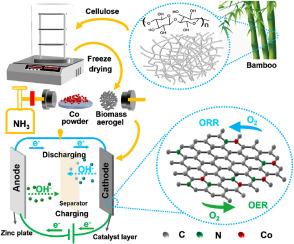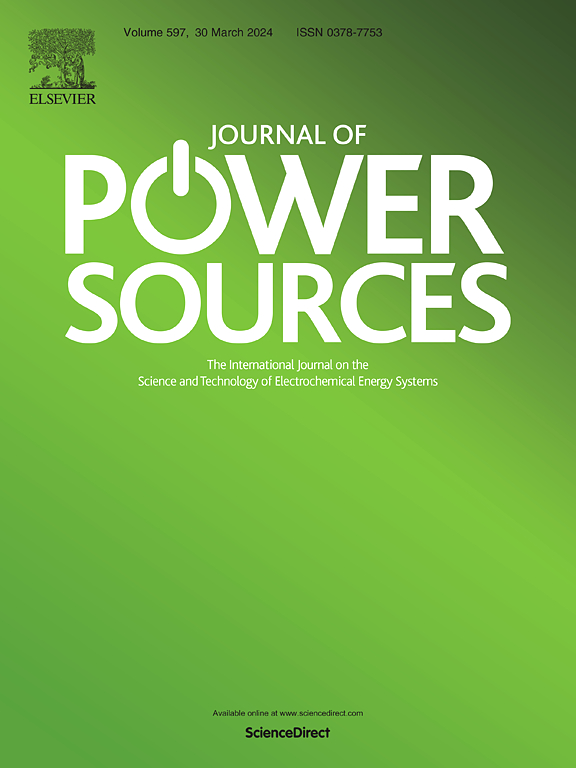Bamboo-derived aerogel with atomically dispersed Co as a high-performance bifunctional electrocatalyst for durable zinc-air batteries
IF 8.1
2区 工程技术
Q1 CHEMISTRY, PHYSICAL
引用次数: 0
Abstract
The development of highly efficient and durable bifunctional electrocatalysts is crucial for rechargeable zinc-air batteries, which have garnered significant attention as a promising sustainable energy storage technology. Herein, a novel Co-N-C-1050 catalyst is synthesized using a high-temperature gas transport method, where high purity cobalt powder and bamboo biomass aerogel are treated with ammonia gas at 1050 °C. The resulting catalyst exhibits a 3D interconnected porous network composed of dense carbon fibers, which atomically dispersed Co, N, and C elements are uniformly distributed. The synergistic integration of highly active Co single atoms and N-doped 3D carbon fiber aerogel enables Co-N-C-1050 to demonstrate excellent bifunctional electrocatalytic performance for oxygen reduction reaction (ORR) and oxygen evolution reaction (OER), comparable to commercial Pt/C and RuO2 catalysts. This catalyst has a half-wave potential of 0.842 V for ORR and a potential of 1.472 V at 10 mA cm−2 for OER, outperforming N-C-1050 and benchmark catalysts. A zinc-air battery is driven by Co-N-C-1050 achieves a high power density of 135 mW/cm2 and exceptional stability over 138 h of charge/discharge cycling, surpassing the higher-cost Pt/C + RuO2 catalyst. This biomass aerogel based single-site Co-N-C catalyst offers a promising approach for developing high-efficiency and long-cycle-life zinc-air batteries.

含有原子分散钴的竹材气凝胶是耐用锌-空气电池的高性能双功能电催化剂
高效耐用的双功能电催化剂的开发对于可充电锌-空气电池至关重要,锌-空气电池作为一种前景广阔的可持续能源存储技术已引起广泛关注。本文采用高温气体传输方法合成了一种新型 Co-N-C-1050 催化剂,即在 1050 °C 下用氨气处理高纯度钴粉和竹生物质气凝胶。所得催化剂由致密的碳纤维组成三维互连多孔网络,原子分散的 Co、N 和 C 元素均匀分布。高活性 Co 单原子与掺杂 N 的三维碳纤维气凝胶的协同整合,使 Co-N-C-1050 在氧还原反应(ORR)和氧进化反应(OER)中表现出卓越的双功能电催化性能,可与商用 Pt/C 和 RuO2 催化剂媲美。这种催化剂在进行 ORR 反应时的半波电位为 0.842 V,在 10 mA cm-2 时进行 OER 反应时的电位为 1.472 V,性能优于 N-C-1050 和基准催化剂。由 Co-N-C-1050 驱动的锌-空气电池实现了 135 mW/cm2 的高功率密度和 138 h 充放电循环的卓越稳定性,超过了成本更高的 Pt/C + RuO2 催化剂。这种基于生物质气凝胶的单位 Co-N-C 催化剂为开发高效率、长循环寿命的锌-空气电池提供了一种前景广阔的方法。
本文章由计算机程序翻译,如有差异,请以英文原文为准。
求助全文
约1分钟内获得全文
求助全文
来源期刊

Journal of Power Sources
工程技术-电化学
CiteScore
16.40
自引率
6.50%
发文量
1249
审稿时长
36 days
期刊介绍:
The Journal of Power Sources is a publication catering to researchers and technologists interested in various aspects of the science, technology, and applications of electrochemical power sources. It covers original research and reviews on primary and secondary batteries, fuel cells, supercapacitors, and photo-electrochemical cells.
Topics considered include the research, development and applications of nanomaterials and novel componentry for these devices. Examples of applications of these electrochemical power sources include:
• Portable electronics
• Electric and Hybrid Electric Vehicles
• Uninterruptible Power Supply (UPS) systems
• Storage of renewable energy
• Satellites and deep space probes
• Boats and ships, drones and aircrafts
• Wearable energy storage systems
 求助内容:
求助内容: 应助结果提醒方式:
应助结果提醒方式:


